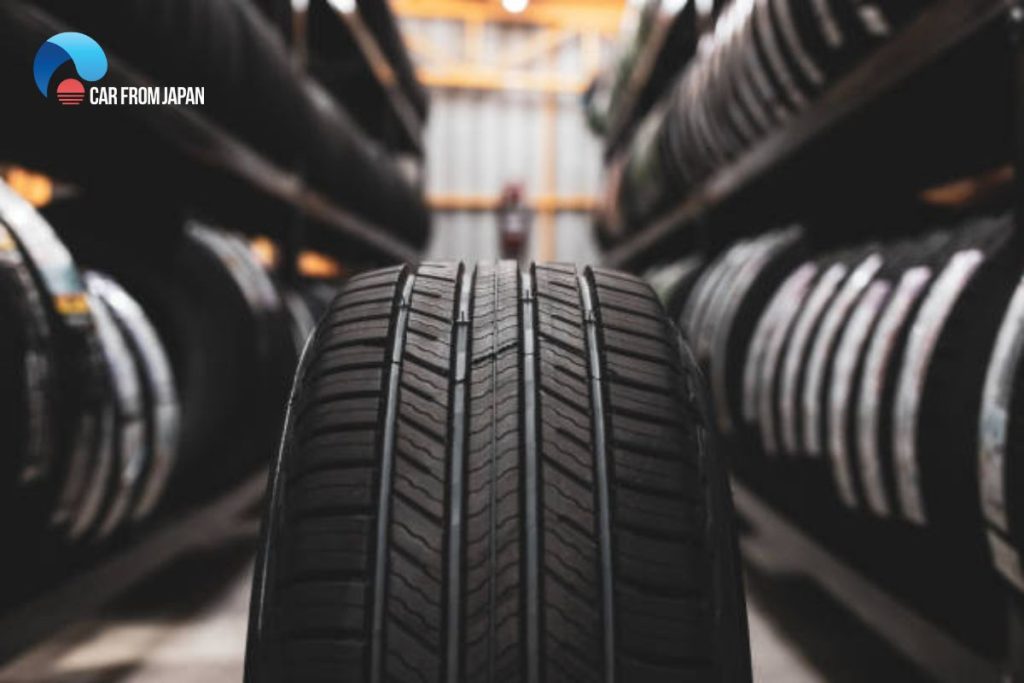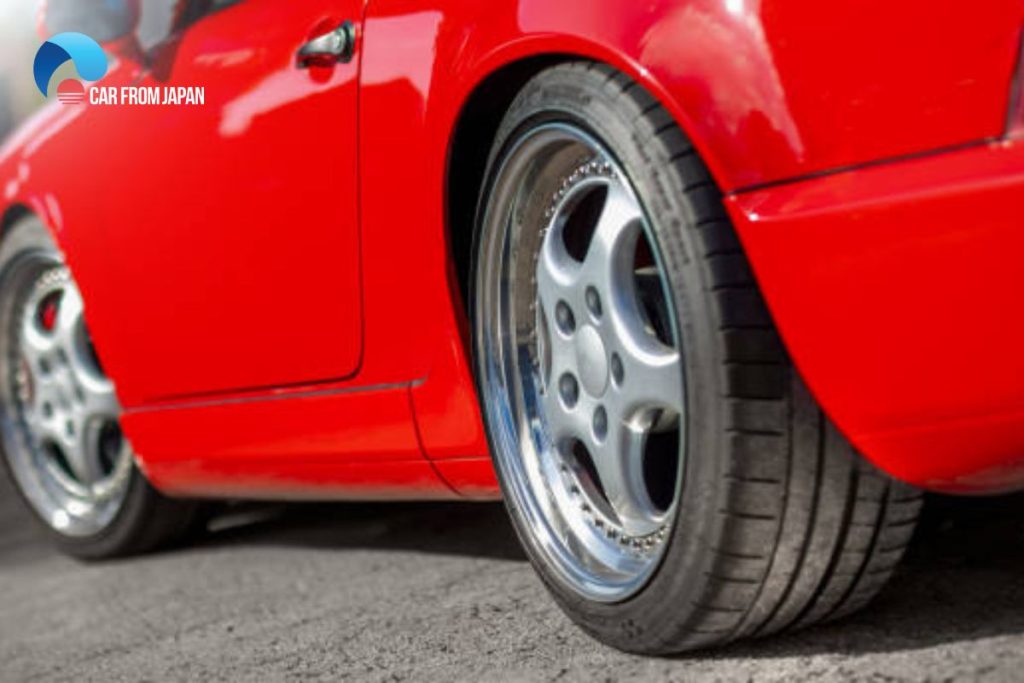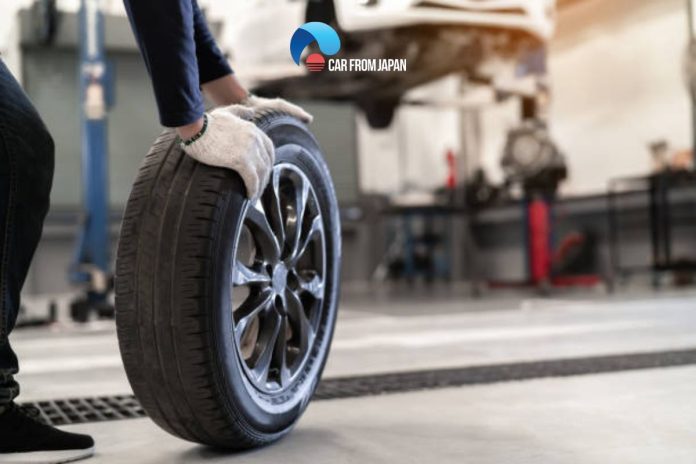Vehicles imported from Japan are highly popular among U.S. drivers. Statista reports that around 1.49 million cars were imported from Japan to the U.S. in 2023, and this number is constantly growing. U.S. motorists choose this option because of the advanced engineering, unique designs, and reliability that Japanese manufacturers invest in the car manufacturing industry.
What tires fit Japan-imported vehicles the best? How do we choose the right tires, considering the different Japanese sizing systems and the different road conditions of the two territories?
The Car From Japan staff asked famous tire seller NeoTires to answer all your questions, from the most recommended tires to what you need to know when choosing a vehicle imported from Japan.
Contents
Why is Tire Replacement Recommended with Japan-Imported Cars?
Tire replacement is highly recommended when bringing a Japanese car to the U.S. for several reasons:
- Road Regulations: Each state and country has its own road regulations. Passenger tires in the U.S. meet the DOT standards. This means that the tire meets all safety standards the Department of Transportation established. Japanese regulations may be different. Replacing tires when importing the vehicle ensures that they meet both legal and safety standards.
- Tire Age: Tires on imported vehicles may be old, and the driver may not know in what conditions they were previously stored. Despite low mileage, older tires deteriorate, reducing both safety and performance;
- Weather Conditions: Japanese manufacturers produce tires according to the weather conditions specific to Japan’s territories. As such, these tires might not perform well in U.S.-specific weather like extreme summer heat and harsh winters.

Also, as per NeoTires survey, approximately 52.5% car owners in the USA order tire replacements at their website when importing their cars from Japan. This is because it helps them be more confident about their vehicle performance in compliance with local laws, safety, and weather compatibility.
How U.S. roads affect tire wear differently than in Japan
Drivers can expect faster tire wear on U.S. roads than in Japan. Japanese road surfaces are generally smoother, with over 90 percent of roads and highways paved. In addition, the superior maintenance of Japanese urban and interurban roads contributes to reduced tire wear.
In contrast, 39% of the U.S. major roads are in poor to mediocre condition, according to infostructurereportcard.org. Extreme weather events leading to road deterioration, potholes, and rugged rural routes impact tire wear rate.
Best Tires for Japanese Imported Cars in the U.S.
Drivers who choose Japanese imports are advised to choose their tires according to the type of vehicle, driving style, and performance needs in the conditions they drive most often. Below, you will find a list of recommended tires by vehicle (sedan, SUV, sports, kei). You will also find a short description of each product’s strengths to find the best match more easily.
Best tires for Japanese Sedans
Some popular Japanese sedans in the U.S. are the Honda Accord JDM, Nissan Skyline, and Toyota Crown. These are preferred for their fuel efficiency, compactness, and steady and comfortable ride.
Depending on the weather and road conditions in your U.S. area and your performance preferences, you can equip Japanese sedans with Michelin Pilot Sport 4S, Bridgestone Turanza QuietTrack, or Continental ExtremeContact DWS 06 Plus tires.
For example, the Michelin Pilot Sport 4S is an excellent option for performance-oriented sedans. On most U.S. urban roads, this tire offers a dynamic response, sporty handling, superior grip, and steadiness.
The Bridgestone Turanza QuietTrack is an alternative option for drivers focused on longevity and comfort. Slightly more affordable than the Pilot Sport 4S, it has a much more durable and versatile tread pattern adapted for various weather conditions.
Lastly, the Continental ExtremeContact DWS 06 Plus perfectly complements Japanese sedans exploring dry and wet roads. The product performs steadily in hydroplaning conditions and is optimized for firm cornering and agile breaking. In addition, the ExtremeContact DWS 06 Plus maximizes fuel efficiency, making it a long-term investment.
Best tires for Japanese SUVs
Japan SUV imports like the Nissan X-Trail, Mitsubishi Pajero, and Toyota Land Cruiser need tires that can handle their weight and deliver performance on various terrains, from smooth highways to rugged off-road. Three popular products to meet this goal include BFGoodrich All-Terrain T/A KO2, Michelin Defender LTX M/S, and Falken Wildpeak A/T Trail.
The BFGoodrich All-Terrain T/A KO2 is a good choice for adventurers exploring rugged terrain and off-road surfaces. This tire has a highly aggressive tread with deep grooves that provide solid traction in mud, gravel, rock, and deep snow. The tire is highly ranked for its durability and resistance to damage, but it is unsuitable for highway surfaces.
In contrast, the Michelin Defender LTX M/S is exactly what you need for highway SUVs that cover long distances. This product’s strengths are tread longevity, comfort, noise suppression, year-round traction, and dependable performance. The Defender LTX M/S is expected to last up to 80,000 miles – a promising warranty, even for the all-season tire segment.
Finally, the Falken Wildpeak A/T Trail is a hybrid product that adapts perfectly to both smooth and off-road terrain. Its special design makes it ideal for drivers who spend time on rough surfaces and smooth highways.
While in “off-road mode,” the Wildpeak A/T Trail provides steady traction and easily resists extra load. Once switching to highway surfaces, the tire minimizes the road noise, making the ride quiet and comfortable.

Best tires for Japanese sports cars
Many Japanese imports are high-performance—perfect for those who like sporty and agile driving. Some common examples include the Nissan 350Z and Mazda RX-7, which need matching tires. Some high-ranking recommendations are the Bridgestone Potenza RE-71 RS, Toyo Proxes R1R, and Yokohama Advan Neova AD08R.
All three models are high-performance summer tires, superbly matching the specifics and capabilities of Japanese sports cars. The difference lies in their price category, with the Toyo Proxes R1R being the most affordable at most dealers.
As for the performance ratings, all three models deliver superior grip in dry and wet conditions, precise handling, and high cornering stability.
What Tire Sizes Work Best for Kei Cars in the U.S.?
Considering the small size of Japanese kei cars such as Suzuki Alto or Honda Beat, they usually use compact tire sizes. The recommended size for these vehicles ranges between 155/65R13, 165/55R14, and 175/55R15, or anything close to these sizes with a narrow width of 155-175 mm, a small diameter of 13-15 inches, and a low profile height.
The optimal tire size can vary depending on the specific kei car model. For the best match, we recommend checking the vehicle’s manual or the sidewall of the tires came with the car.
Best tires for Japanese Kei Cars
Kei cars need special tires to match their compact weight and provide responsive handling to compensate for their limited power. To that end, we recommend you buy Continental TrueContact Tour or the Yokohama AVID Ascend GT.
The TrueContact Tour tire has a lightweight construction that matches the lightweight of kei cars. In addition, the tire provides low rolling resistance, improving fuel efficiency for small kei car engines. This product offers optimal performance for urban driving- the environment in which kei cars primarily operate.
The Yokohama AVID Ascend GT is available in sizes designed for kei cars. This product provides enhanced stability, essential for kei cars’ high center of gravity. A bonus is the comfort and low road noise this tire offers – a necessary aspect of daily urban rides.
Tire Size Conversions: Japan vs. U.S. Standards
The tire sizing systems in Japan and the U.S. have no meaningful differences. Both rely on the P-metric tire size system, which results in exact width measurements and identical aspect ratio calculations.
For example, a tire on a vehicle imported from Japan with the sizing 215/45R17 will be universally understood and replaced with another tire of the same size in the U.S.
While both markets generally accept the P-metric system, tire labeling standards can differ. The U.S. relies on DOT standards, while Japan follows the JIS (Japanese Industrial Standards). This means that Japan-specific tires might have additional markings not found on a U.S.-specific tire (symbols for Japan-specific roads, weather conditions, or compliance info).
Despite these possible minor labeling differences, the physical tire size is identical (with minor exceptions) between both markets.
Buying Tires for Japanese Imported Cars: Additional Considerations
When looking for tires on a Japan import, consider your seasonal needs and tire potential lifespan, not just size, price, and performance.
If you live in a snowy U.S. region, consider dedicated winter tires. The Bridgestone Blizzak WS90 is a good starting point for dealing with harsh weather conditions.
Tires might wear faster because of the lightweight chassis and optimized suspension of Japanese imported cars. We recommend checking for tires with a higher treadwear rating. These provide longer service life, making them a long-term investment.
Bottom Line
The right tires can make the difference whether it’s about a Japanese import or any other vehicle. It’s impressive how a piece of rubber rolling on the road can determine your ride’s comfort, safety, and performance.
Choosing them wisely and consulting an expert is essential when you’re unsure how to match them with your car. The tread design, size, and pattern in compliance with the U.S. road and weather conditions can make your driving experience good or bad, depending on your choice. Drive safe, and choose your tires wisely!



